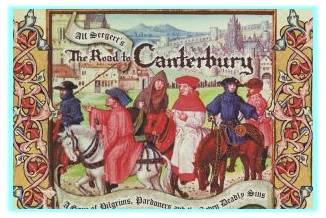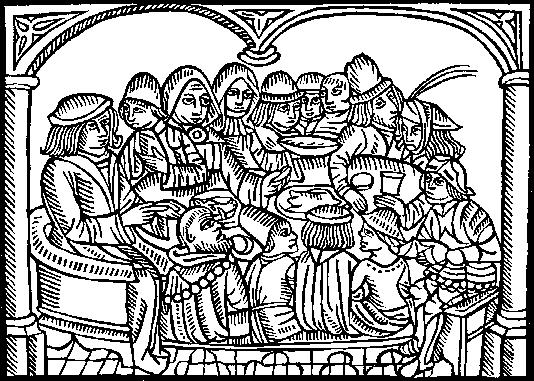The Good-Morrow: A Critical Analysis:
 A cursory glance upon John Donne’s The Good Morrow will regard it as a
conventional love poem that derives its form from two related genres in
Renaissance love poetry: aubade, a
morning serenade of a lover to mistress and a similar popular literary form: aube, a love poem which presents a
conversation between two lovers as they wake up at dawn after a night of love
making. This later genre was one which Donne used on other occasions in Break of Day and The Sun Rising where he worked for somewhat different effect in his
handling of it. The standard dramatic situation for this literary form is established in The Good Morrow by the implications of the title and by the rather
oblique indications of lines 8-11 and 15-16 which present a bed-room scene in which two lovers lie peacefully in
the morning gazing at each other.
A cursory glance upon John Donne’s The Good Morrow will regard it as a
conventional love poem that derives its form from two related genres in
Renaissance love poetry: aubade, a
morning serenade of a lover to mistress and a similar popular literary form: aube, a love poem which presents a
conversation between two lovers as they wake up at dawn after a night of love
making. This later genre was one which Donne used on other occasions in Break of Day and The Sun Rising where he worked for somewhat different effect in his
handling of it. The standard dramatic situation for this literary form is established in The Good Morrow by the implications of the title and by the rather
oblique indications of lines 8-11 and 15-16 which present a bed-room scene in which two lovers lie peacefully in
the morning gazing at each other.
Though the normal tone of this
literary form is one of relaxed, tender eroticism, Donne breaks this pattern,
as he did in The Sun Rising, by
starting the poem with colloquial phrasing,
the heavy stress and broken rhythm of an impassioned speech: “I wonder, by my troth, what thou and I/ Did,
till we loved?” The lover is astonished to discover that he and his mistress
have wasted their time in simple childish “country pleasure” that are described
by the breast feeding images like “weaned” and “sucked” before their last night
of love making. They might have hidden themselves and their mind like the seven
christian young men of Ephesus who escaped Roman persecution by sleeping in
cave. But the pleasure which the poet
has experienced is not a nonsexual one. Rather it refers to the sexual conquest
which is revealed by the words “pleasure”, “beauty”, “desired”, “got” that have
specific usage in Donne’s vocabulary in the following lines:
“ ’Twas so; but this, all pleasures
fancies be.
If ever any beauty I did see,
Which I desired, and got, ’twas but a dream of thee.”
Donne uses “beauty”
in a sense roughly equivalent to the modern slang use of “babe”, “desired” and “got”
have a specifically sexual implication. Similarly “pleasure” was strictly
restricted to the meaning sensual pleasure. They seem merely a “dream” of her,
a shadowy manifestation of the ultimate reality which she embodies.
In the early stanza we find that the
two lovers especially the speaker are not young innocents who have just
discovered sex. They are old hands at
the game. Therefore they had thought that love was nothing more than lust. But he
present love affair unlike the lover’s fleshly liaisons. It has brought about
awakening of their souls and their souls have entered as active agents into a new
realm of experience. This is stated in the following line: “And now good-morrow
to our waking souls”. In their new experience of love, they do not watch one
another out of suspicions and fear of infidelity which trouble ordinary lovers
because this love is strong a force that it overpowers any desire which may divert their attention to anything outside. The small
bed room, which shuts out the world, serves as a symbol for the entire contentment
of a love that enables them to renounce not only other loves but also all of
the normal activities of life in the world. That’s why the poet says:
“Let sea-discoverers to new worlds
have gone,
Let maps to other, worlds on worlds have shown,
Let us possess one world, each hath one, and is one.”
These images
of “sea-discoverers” and map-readers, if taken literally, are used by Donne to differentiate
his love which is fixed, self-satisfied and has a world of its own from the
frantic adventurous curiosity, heroism and the romance of life of Renaissance.
But if we penetrate into these literal meaning, we will find that the poet
associated these images of “sea-discoverers” with the immature physical restless
instability of love which is called in the first stanza childish country
pleasure and “all love of other sights” in the poem.
In the next stanza the poet again
returns to the bed scene where each
lover finds his and her face reflected on the other’s eye: My face in
thine eye, thine in mine appears,/ And true plain hearts do in the faces rest;”.
At the end of the previous stanza the poet has presented each of the lovers as
a complete world, in absolute possession of the separate world of other ( “each
hath one, and is one”). But now in the above lines he presents these two worlds
as a single globe made up of two congruent hemispheres. Thus Donne makes a
logical transition from a conception of the love relationship as the lover’s
complete possession of one another to a conception of love as a fusion of the
lover’s soul into a single new identity. As Donne develops this metaphor, he
presents the globe formed by the two hemisphere as characterised by the same
qualities of permanence and peace which were implied by his characterisation of
the love in the statement: “true plain hearts do in the faces rest”. It is “without
sharp north, without declining west”. Drawing the evidence of scholastic
philosophy, the poet says: “Whatever dies, was not mixed equally”. But the poet
thinks their love is immortal and permanent. Unlike the gross union of the
unstable matter of lovers’ bodies, their love is a pure union of the eternal
substance of lover’s soul to the heavenly sphere: “If our two loves be one, or,
thou and I/ Love so alike, that none do slacken, none can die.”
The poem is typical love poem in
which Donne discards the clowning and antic poses of his early love poetry and
treats love with a gravity and richness of thought and emotion. The central
idea of the poem that the long inner debate of body and soul can be resolved in
wholly satisfying love which includes both physical sex and spiritual union
points out to Neo-Platonism. But the poet comes to his conclusion not by
emotional assertion but by logical analysis drawing examples and images from
various spheres of knowledge. But Donne’s
technique in spite of his scholarly references is not pedantic and appeals to
the readers for its depth of thought and sincerity of feeling and emotion. Thus here occurs What T. S. Eliot says “association of sensibility” while praising
the poetry of Donne.







